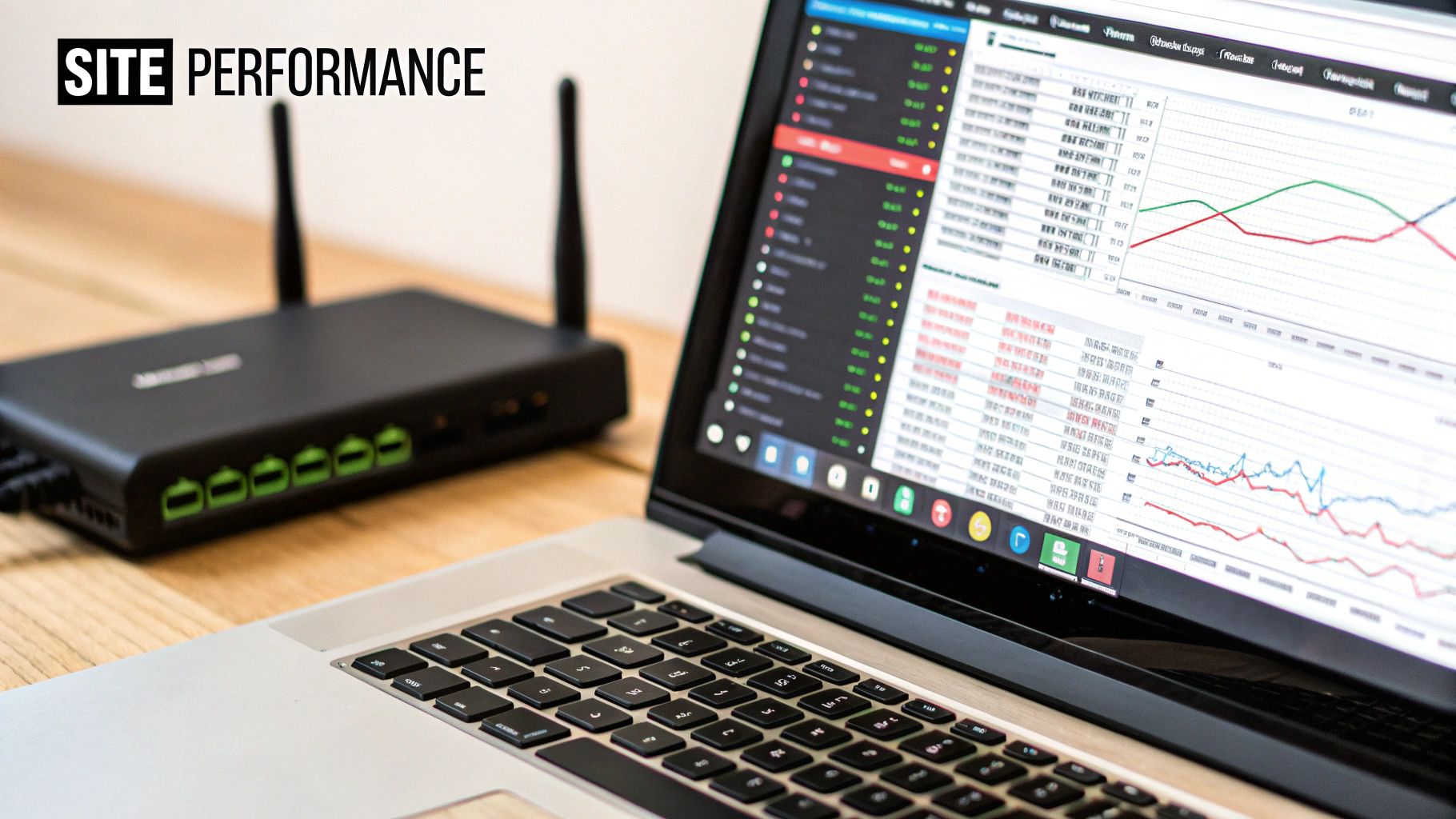In the crowded digital marketplace, simply having a website is not enough; it must be discoverable. Achieving high visibility in search engines and across the web is the cornerstone of digital success. It drives organic traffic, builds brand authority, and ultimately, converts visitors into loyal customers.
But with algorithms constantly evolving and competition growing fiercer, a simple approach is no longer sufficient. The key to success is a multi-faceted strategy that goes beyond basic SEO. This comprehensive guide will walk you through nine powerful, field-tested methods designed to significantly improve website visibility.
You will learn how to master technical optimizations, leverage content marketing, and build a stellar online reputation. We'll cover everything from local SEO and link building to integrating social media and email marketing. Each point is a critical piece of the puzzle, providing actionable steps to elevate your online presence. Prepare to transform your website from a digital ghost into a dominant force with these expert-backed strategies.
Search Engine Optimization (SEO) is the foundational practice of enhancing a website to achieve higher rankings in search engine results pages (SERPs). It’s a multifaceted discipline that involves technical adjustments, strategic content creation, and authority building to make your site more appealing to search algorithms like Google's. The primary goal is to improve website visibility for relevant queries, driving organic, high-intent traffic without paying for ads. By systematically optimizing your digital assets, you align your content with what both users and search engines are looking for.

Successful implementation can transform a business. For instance, the e-commerce giant Zappos built its authority not just with ads but through incredibly detailed product descriptions and a massive volume of authentic user reviews, which function as unique, long-tail content. Similarly, Canva’s dominance in search results stems from a powerful topic cluster strategy, where they create comprehensive pillar pages supported by numerous related articles, allowing them to rank for millions of keywords.
To effectively improve website visibility through SEO, move beyond outdated practices like simple keyword stuffing. Instead, focus on a holistic strategy that prioritizes user experience and topical relevance.
Content marketing is the strategic practice of creating and distributing valuable, relevant, and consistent content to attract and retain a clearly defined audience. Unlike direct advertising, this approach focuses on providing genuine utility to users, building brand authority, and establishing trust. By delivering high-quality information, you can improve website visibility organically as your content earns shares, links, and high search rankings, ultimately guiding potential customers toward your business.

This strategy's power is evident in major brand successes. Red Bull has become a media powerhouse not by advertising energy drinks, but by producing thrilling extreme sports content that generates billions of views. Similarly, Buffer built its reputation and a loyal community through radical transparency in its blog posts, sharing everything from salary formulas to revenue dashboards. These examples show that content which educates, entertains, or inspires is a powerful magnet for audience attention and loyalty. For more information, explore these Content SEO best practices from indexpilot.io.
Effective content marketing goes beyond just publishing blog posts. It requires a documented strategy that aligns with your business goals and addresses your audience’s specific pain points.
Social Media Marketing leverages platforms like Instagram, X (formerly Twitter), Facebook, and LinkedIn to build brand awareness, foster community, and drive targeted traffic to your website. While often seen as separate from SEO, a strong social presence creates powerful "social signals" that search engines interpret as indicators of brand authority and relevance. The core objective is to improve website visibility by meeting your audience where they are most active, creating a direct funnel back to your core digital properties.

The impact of a viral or community-focused strategy can be monumental. For example, Dollar Shave Club’s initial YouTube video generated over 4.75 million views in its first three months, launching the brand into the mainstream. Similarly, the beauty brand Glossier built its $1.2 billion valuation almost entirely through an Instagram-first strategy, cultivating a loyal community that co-created the brand's direction. These examples show how social platforms can serve as a primary engine for growth and visibility. You can learn more about driving traffic from social and other channels on the IndexPilot blog.
Effective social media marketing requires more than just broadcasting promotional messages. It’s about creating value, fostering interaction, and building genuine relationships that translate into brand loyalty and referral traffic.
Pay-Per-Click (PPC) advertising is a powerful digital marketing model that allows you to purchase visits to your site rather than earning them organically. Platforms like Google Ads and Microsoft Advertising enable you to bid for ad placement in a search engine's sponsored links when someone searches a keyword related to your business. This strategy offers immediate results, allowing you to improve website visibility and capture high-intent traffic from day one. To fully grasp this powerful strategy, it's essential to understand what is PPC and how it works as a core component of digital marketing.

The impact of a well-executed PPC campaign is clear and measurable. For example, Slack famously accelerated its growth from 15,000 to 500,000 users by leveraging targeted PPC campaigns to reach early adopters. Similarly, WordStream has showcased how optimized Google Ads campaigns can increase client leads by as much as 300% by refining targeting and ad copy. These examples highlight PPC’s ability to generate immediate, scalable results when managed effectively.
Effective PPC management is about more than just bidding on keywords; it requires strategic planning, continuous optimization, and a focus on return on investment. A data-driven approach is critical to maximizing your budget and achieving your visibility goals.
Local SEO Optimization is the practice of enhancing your online presence to attract more business from relevant, location-based searches. This is essential for any business with a physical storefront or one that serves a specific geographic area, as it directly targets users searching for products or services "near me." The primary goal is to improve website visibility within a localized context, especially in Google's "Local Pack" and on Google Maps, driving high-intent foot traffic and local online conversions.
Success in local search can dramatically impact a business's bottom line. For example, Domino's Pizza boosted local orders by a reported 30% by fully optimizing its Google Business Profile listings across thousands of locations. Likewise, many local law firms have seen massive increases in qualified leads by implementing a targeted local SEO strategy, proving that it’s not just for retail or restaurants. These examples show how mastering local signals translates directly to tangible business growth.
To effectively improve website visibility in your service area, focus on building trust and relevance signals that Google's local algorithm values. This means demonstrating that you are a prominent, active, and reputable entity within a specific community.
Technical Website Optimization involves fine-tuning your site's infrastructure to ensure it is fast, secure, and easily accessible to search engine crawlers. This goes beyond content and focuses on the underlying framework, including site speed, mobile responsiveness, security protocols (HTTPS), and a clean site structure. The core goal is to remove any technical barriers that could hinder search engines from efficiently crawling, indexing, and ranking your pages, which is fundamental to improve website visibility and provide a superior user experience.
The impact of technical excellence is well-documented. Pinterest famously reduced its perceived page load times by 40%, leading to a 15% increase in search engine traffic. Similarly, AliExpress improved its page speed by 36% and saw a corresponding 10.3% rise in conversion rates, demonstrating the direct link between technical performance and business outcomes. These examples, championed by web performance experts like Ilya Grigorik and Patrick Meenan, prove that a well-oiled machine performs better for both bots and humans.
Effective technical optimization ensures your high-quality content can actually be found and appreciated. It's about building a solid foundation for all other SEO efforts to rest upon.
Link Building and Authority Development is the process of acquiring inbound links, or backlinks, from other reputable websites to your own. These backlinks act as votes of confidence, signaling to search engines like Google that your content is credible, trustworthy, and authoritative. A robust backlink profile is a critical ranking factor, directly helping to improve website visibility by boosting your site's domain authority and search engine rankings. It's a strategic effort that moves beyond simple link acquisition to focus on earning endorsements through value and relationships.
This strategy's power is evident in major digital marketing successes. Ahrefs, for example, generated over 73,000 backlinks by offering powerful free SEO tools that other sites naturally linked to as valuable resources. Similarly, Brian Dean of Backlinko popularized the "Skyscraper Technique," a method of finding popular content and creating a superior version, which helped him acquire 516% more backlinks on a target article. These examples show how creating genuine value is the most sustainable way to build authority.
Effective link building prioritizes quality and relevance over sheer quantity. A single authoritative link can be more impactful than dozens of low-quality ones. A crucial aspect of SEO involves acquiring high-quality backlinks, and understanding effective strategies for securing high-quality backlinks to boost domain authority can significantly enhance your site's credibility.
Email marketing integration is the strategic use of email campaigns to drive repeat traffic back to your website, nurturing a direct relationship with your audience. Unlike channels that depend on algorithms, email provides a controlled, owned line of communication to your most engaged followers. This strategy combines targeted list-building, thoughtful segmentation, and valuable content delivery to maintain ongoing engagement and improve website visibility long after a user's first visit. By bringing users back consistently, you signal to search engines that your site is a valuable resource worth returning to.
This approach has built empires. Morning Brew, for example, cultivated a loyal audience of over 4 million subscribers primarily through its daily newsletter, driving millions of pageviews to its website. Similarly, TheSkimm created an indispensable daily habit for its 7 million+ readers, becoming a primary source of news and traffic. ConvertKit, founded by Nathan Barry, not only provides email marketing tools but grew its own business from $0 to over $20 million in ARR by educating its audience through powerful email-driven content strategies.
To effectively use email to boost your site’s authority and traffic, focus on delivering genuine value directly to the inbox. This transforms your email list from a simple notification system into a powerful engagement engine. For a deeper dive, you can explore more on Email Marketing Integration on indexpilot.io.
Online Reputation Management (ORM) is the strategic process of monitoring, influencing, and controlling how your brand is perceived across the internet. It goes beyond reactive damage control; it’s a proactive strategy to shape your digital narrative in search results, on review sites, and across social media. The core goal is to improve website visibility for positive assets while mitigating the impact of negative mentions, ensuring that potential customers see the best version of your brand first. By actively managing your online footprint, you build trust, credibility, and a resilient public image that can withstand scrutiny.
Successful ORM can redefine a brand's trajectory. For instance, after facing a major public relations crisis, United Airlines invested heavily in proactive social media engagement and customer service to rebuild its damaged reputation. Similarly, Airbnb's massive scale is sustained by a sophisticated system for managing millions of host and guest reviews, which is essential for maintaining trust and encouraging bookings. Both examples show how a strong reputation directly fuels visibility and business success.
To effectively improve website visibility with ORM, you must integrate it into your daily marketing operations, not just use it during a crisis. The focus should be on building a "digital fortress" of positive content that naturally outranks any potential negativity.
The journey to improve website visibility is not a linear path but a dynamic, interconnected cycle of strategic actions. We’ve navigated through nine critical pillars, from the foundational bedrock of technical SEO and on-page optimization to the growth-fueling power of content marketing, authoritative link building, and targeted local SEO. Each strategy is a vital cog in a much larger machine, designed to elevate your brand from digital obscurity to a prominent position in your industry.
Viewing these elements in isolation is the most common pitfall. True digital dominance is achieved when these strategies work in concert. Your compelling content marketing efforts are amplified by strategic social media promotion. Your PPC campaigns become more cost-effective when they lead to a technically sound, high-performance website. Your email marketing retains the audience you fought hard to attract through SEO and link building. This synergy creates a powerful feedback loop, where each success builds upon the last, compounding your visibility over time.
To transform this knowledge into tangible results, focus on a unified approach. Don't just publish content; ensure it's technically optimized, promoted across channels, and linked to internally to build topical authority. Don't just build backlinks; ensure they drive relevant traffic to pages that convert. The core principle is integration. Your goal is to build a comprehensive digital ecosystem, not just a collection of siloed marketing tactics.
A critical, often-overlooked thread that ties all content-related efforts together is indexing speed. What good is a perfectly optimized blog post or a new product page if search engines don’t know it exists for days or even weeks? This is where modern automation becomes a non-negotiable asset. Automating the submission of new and updated URLs to search engine APIs bridges the gap between creation and discovery, ensuring your efforts to improve website visibility are recognized almost instantly.
Your next steps should be clear and deliberate. Start by auditing your current efforts against the nine pillars discussed.
Prioritize the areas with the highest potential impact and begin implementing these integrated strategies methodically. Embrace the mindset of continuous improvement, as the digital landscape is always evolving. By mastering these concepts and committing to a holistic, automated approach, you move beyond simply being online to being seen, heard, and trusted. You transform your website from a simple digital brochure into your most powerful asset for growth, engagement, and long-term success.
Ready to eliminate the indexing delays that hold your content back? IndexPilot automates the submission of your new and updated pages directly to Google's Indexing API, ensuring your hard work gets discovered in hours, not weeks. Stop waiting and start ranking faster by visiting IndexPilot to supercharge your website's visibility today.